Analyzing Logistics and Supply Chain Management at Coles Supermarket
VerifiedAdded on 2021/04/21
|25
|7104
|38
Report
AI Summary
This report provides a detailed analysis of the supply chain and logistics management within Coles Supermarkets in Australia. It begins with an executive summary, introduction to the company, and a literature review exploring supply chain management, financial and environmental sustainability, logistics, and corporate social responsibility. The report then outlines the research methodology, including a case study approach and qualitative data analysis. The findings focus on issues of high prices and stock-outs, addressing the principles, theories and the application of the supply chain management. Finally, the report concludes with recommendations for improving Coles' supply chain efficiency and sustainability, referencing the challenges and opportunities within the competitive Australian retail market, and the importance of efficient logistics and supply chain operations.
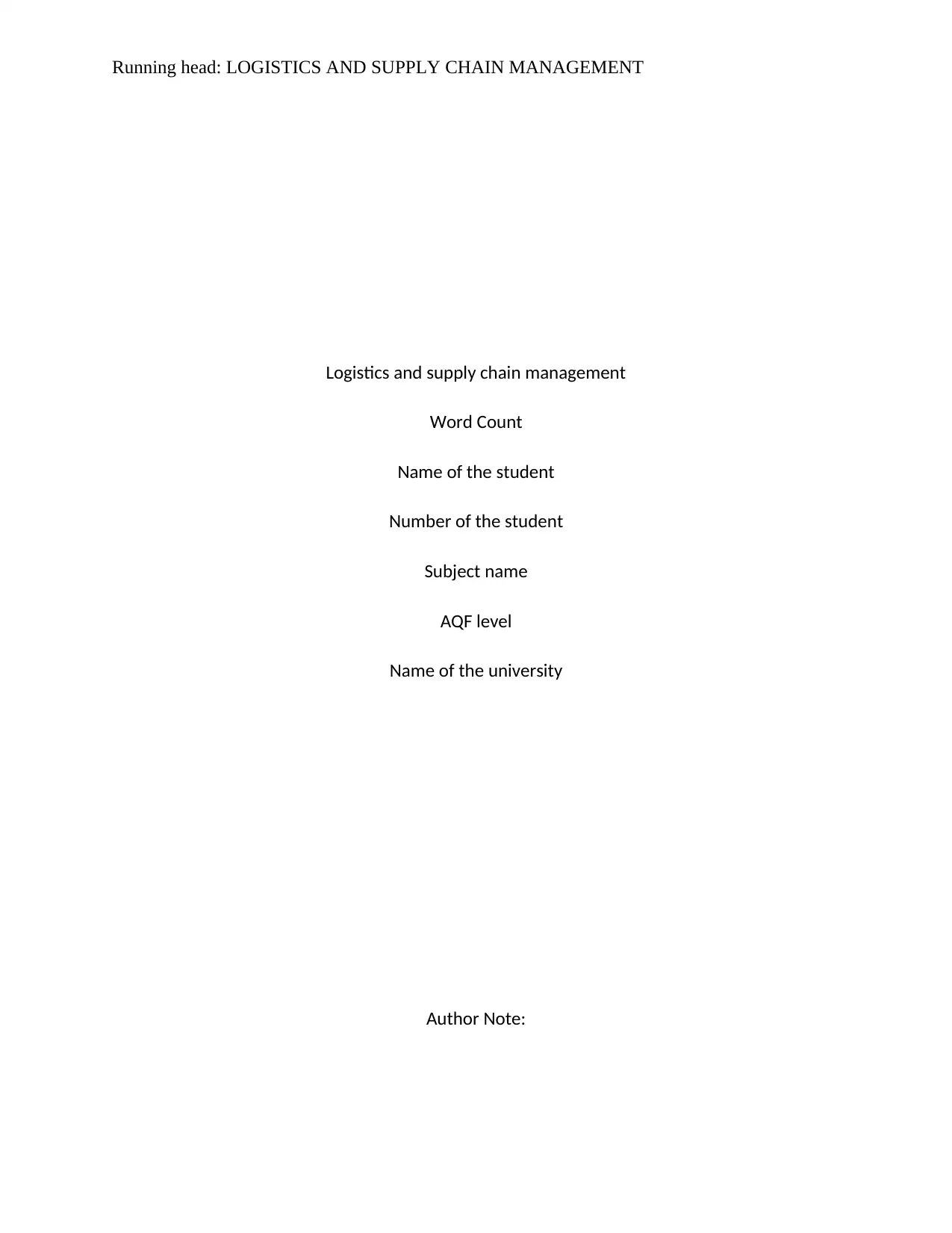
Running head: LOGISTICS AND SUPPLY CHAIN MANAGEMENT
Logistics and supply chain management
Word Count
Name of the student
Number of the student
Subject name
AQF level
Name of the university
Author Note:
Logistics and supply chain management
Word Count
Name of the student
Number of the student
Subject name
AQF level
Name of the university
Author Note:
Paraphrase This Document
Need a fresh take? Get an instant paraphrase of this document with our AI Paraphraser
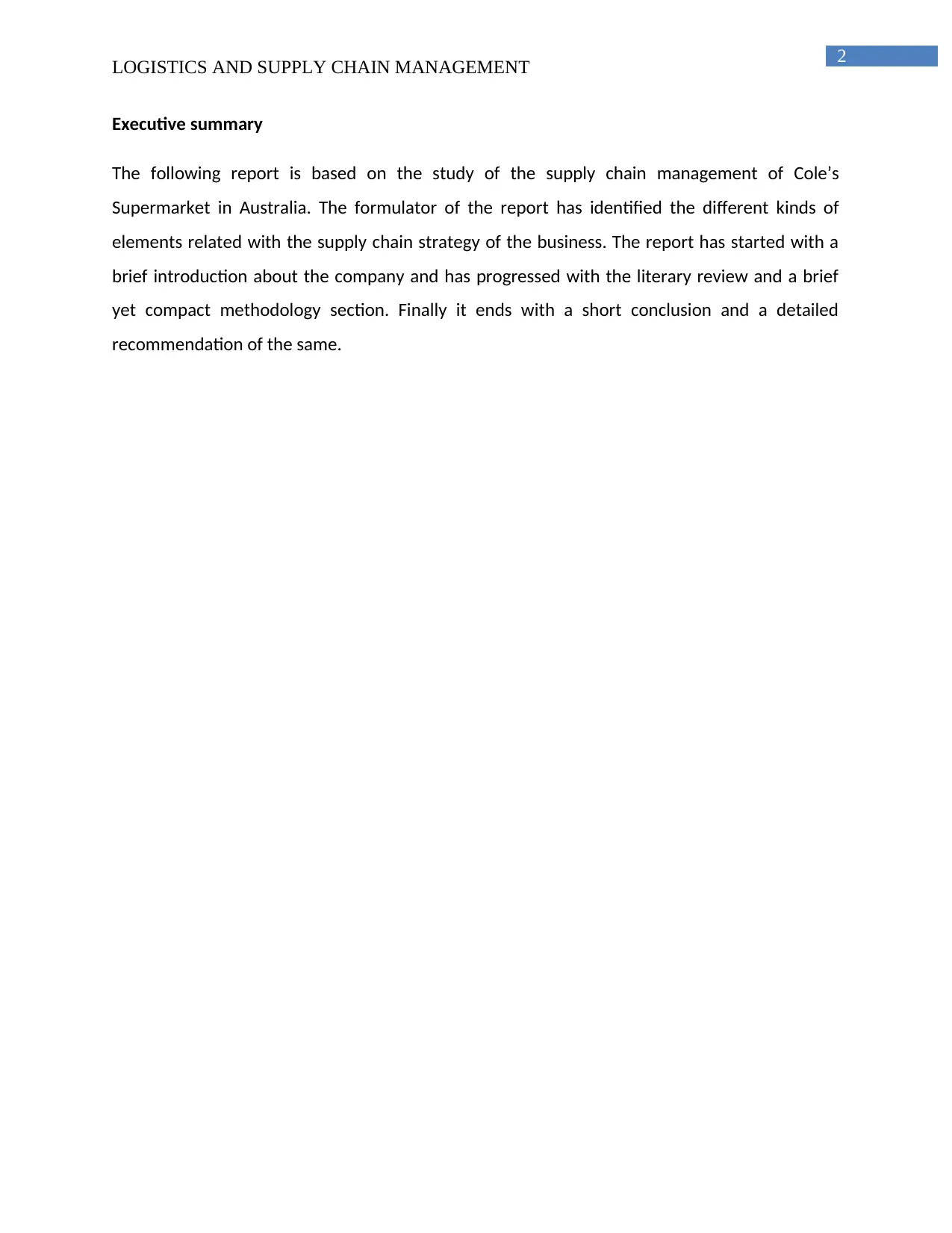
2
LOGISTICS AND SUPPLY CHAIN MANAGEMENT
Executive summary
The following report is based on the study of the supply chain management of Cole’s
Supermarket in Australia. The formulator of the report has identified the different kinds of
elements related with the supply chain strategy of the business. The report has started with a
brief introduction about the company and has progressed with the literary review and a brief
yet compact methodology section. Finally it ends with a short conclusion and a detailed
recommendation of the same.
LOGISTICS AND SUPPLY CHAIN MANAGEMENT
Executive summary
The following report is based on the study of the supply chain management of Cole’s
Supermarket in Australia. The formulator of the report has identified the different kinds of
elements related with the supply chain strategy of the business. The report has started with a
brief introduction about the company and has progressed with the literary review and a brief
yet compact methodology section. Finally it ends with a short conclusion and a detailed
recommendation of the same.
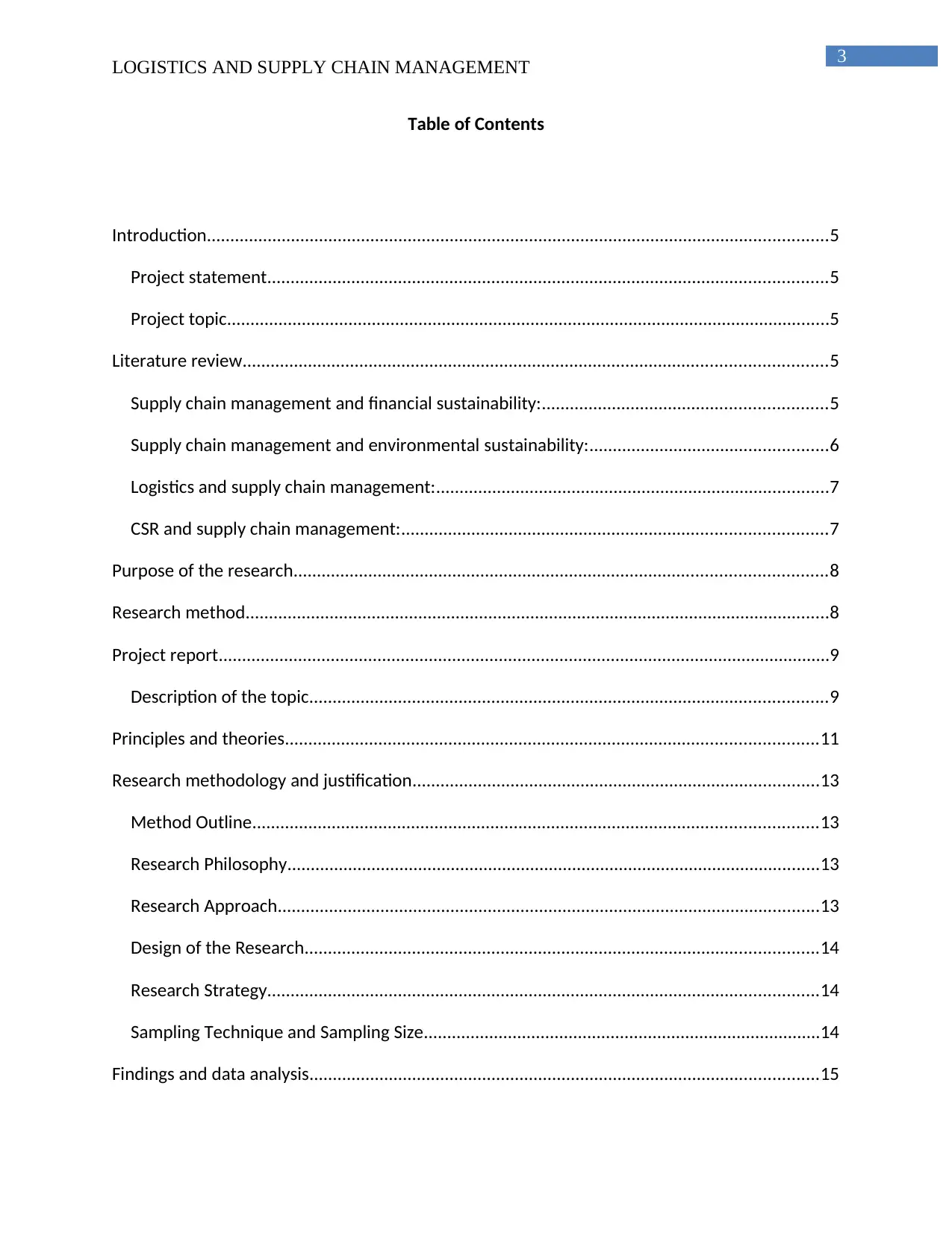
3
LOGISTICS AND SUPPLY CHAIN MANAGEMENT
Table of Contents
Introduction.....................................................................................................................................5
Project statement........................................................................................................................5
Project topic.................................................................................................................................5
Literature review.............................................................................................................................5
Supply chain management and financial sustainability:.............................................................5
Supply chain management and environmental sustainability:...................................................6
Logistics and supply chain management:....................................................................................7
CSR and supply chain management:...........................................................................................7
Purpose of the research..................................................................................................................8
Research method.............................................................................................................................8
Project report...................................................................................................................................9
Description of the topic...............................................................................................................9
Principles and theories..................................................................................................................11
Research methodology and justification.......................................................................................13
Method Outline.........................................................................................................................13
Research Philosophy..................................................................................................................13
Research Approach....................................................................................................................13
Design of the Research..............................................................................................................14
Research Strategy......................................................................................................................14
Sampling Technique and Sampling Size.....................................................................................14
Findings and data analysis.............................................................................................................15
LOGISTICS AND SUPPLY CHAIN MANAGEMENT
Table of Contents
Introduction.....................................................................................................................................5
Project statement........................................................................................................................5
Project topic.................................................................................................................................5
Literature review.............................................................................................................................5
Supply chain management and financial sustainability:.............................................................5
Supply chain management and environmental sustainability:...................................................6
Logistics and supply chain management:....................................................................................7
CSR and supply chain management:...........................................................................................7
Purpose of the research..................................................................................................................8
Research method.............................................................................................................................8
Project report...................................................................................................................................9
Description of the topic...............................................................................................................9
Principles and theories..................................................................................................................11
Research methodology and justification.......................................................................................13
Method Outline.........................................................................................................................13
Research Philosophy..................................................................................................................13
Research Approach....................................................................................................................13
Design of the Research..............................................................................................................14
Research Strategy......................................................................................................................14
Sampling Technique and Sampling Size.....................................................................................14
Findings and data analysis.............................................................................................................15
⊘ This is a preview!⊘
Do you want full access?
Subscribe today to unlock all pages.

Trusted by 1+ million students worldwide
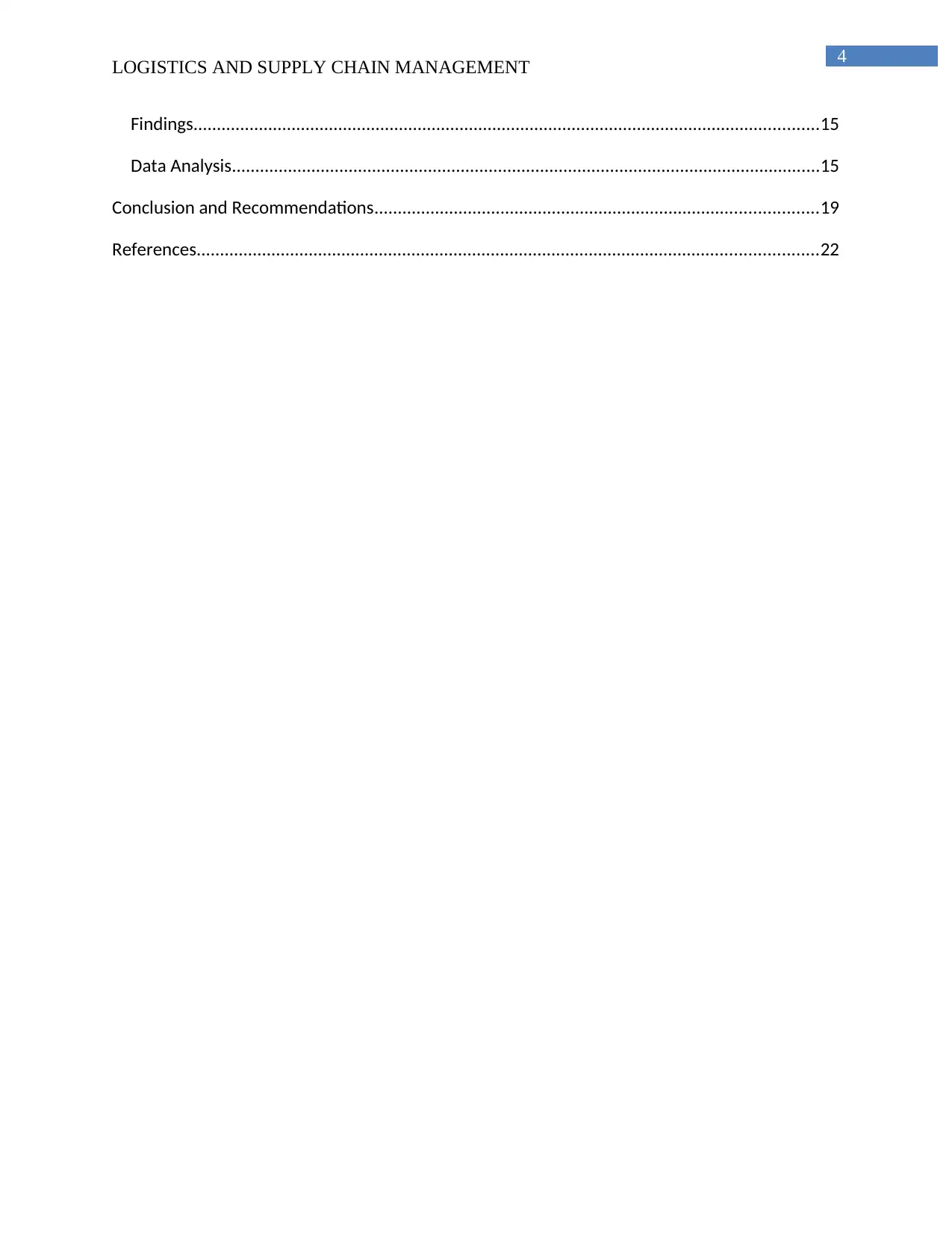
4
LOGISTICS AND SUPPLY CHAIN MANAGEMENT
Findings......................................................................................................................................15
Data Analysis..............................................................................................................................15
Conclusion and Recommendations...............................................................................................19
References.....................................................................................................................................22
LOGISTICS AND SUPPLY CHAIN MANAGEMENT
Findings......................................................................................................................................15
Data Analysis..............................................................................................................................15
Conclusion and Recommendations...............................................................................................19
References.....................................................................................................................................22
Paraphrase This Document
Need a fresh take? Get an instant paraphrase of this document with our AI Paraphraser

5
LOGISTICS AND SUPPLY CHAIN MANAGEMENT
Introduction
Project statement
The supermarket and grocery stores in Australia is considered highly competitive as well
as concentrated. The renowned retail stores in Australia include ALDI, Coles and Woolworths.
With the establishment of ALDI in 2001, the retail industry in Australia has taken a new shape. It
has started growing and developing with a new product line, which gained momentum
alongside the products of Coles and Woolworths. The trend of retail industry started affecting
the shopping behavior of the individuals. Strong competition from the new retail companies
had a significant impact on the traditional companies of Coles and Woolworths (Bailey 2017).
Project topic
This project will focus on the logistics and supply chain management within Coles
Supermarkets in the Australian Supermarket Industry. The content of the particular project will
center on the sustainable supply chains, planning, management and analysis of logistics
functions. The issues with Coles supply chain are associated with its high price for the regular
groceries and their high rate of stock- outs. Customer data has highlighted that the complaint
about stock- out is a long-term issue in Coles supermarket (Brandenburg et al. 2014).
Literature review
The literature for this topic will be totally dependent on the different principles and
elements of Supply Chain Management, corporate social responsibility and sustainability
theory. Previous case studies will be used as a secondary source of information to gather
evidences for the topic. As the theme of this topic will centre on the supply chain management
and logistics of Coles therefore relevant theories have been selected.
Supply chain management and financial sustainability:
Bekaroo, Bokhoree and Pattinson (2016) mention that supply chain management at
Coles and sustainability are closely related. The supermarket chain’s product line consists of
LOGISTICS AND SUPPLY CHAIN MANAGEMENT
Introduction
Project statement
The supermarket and grocery stores in Australia is considered highly competitive as well
as concentrated. The renowned retail stores in Australia include ALDI, Coles and Woolworths.
With the establishment of ALDI in 2001, the retail industry in Australia has taken a new shape. It
has started growing and developing with a new product line, which gained momentum
alongside the products of Coles and Woolworths. The trend of retail industry started affecting
the shopping behavior of the individuals. Strong competition from the new retail companies
had a significant impact on the traditional companies of Coles and Woolworths (Bailey 2017).
Project topic
This project will focus on the logistics and supply chain management within Coles
Supermarkets in the Australian Supermarket Industry. The content of the particular project will
center on the sustainable supply chains, planning, management and analysis of logistics
functions. The issues with Coles supply chain are associated with its high price for the regular
groceries and their high rate of stock- outs. Customer data has highlighted that the complaint
about stock- out is a long-term issue in Coles supermarket (Brandenburg et al. 2014).
Literature review
The literature for this topic will be totally dependent on the different principles and
elements of Supply Chain Management, corporate social responsibility and sustainability
theory. Previous case studies will be used as a secondary source of information to gather
evidences for the topic. As the theme of this topic will centre on the supply chain management
and logistics of Coles therefore relevant theories have been selected.
Supply chain management and financial sustainability:
Bekaroo, Bokhoree and Pattinson (2016) mention that supply chain management at
Coles and sustainability are closely related. The supermarket chain’s product line consists of
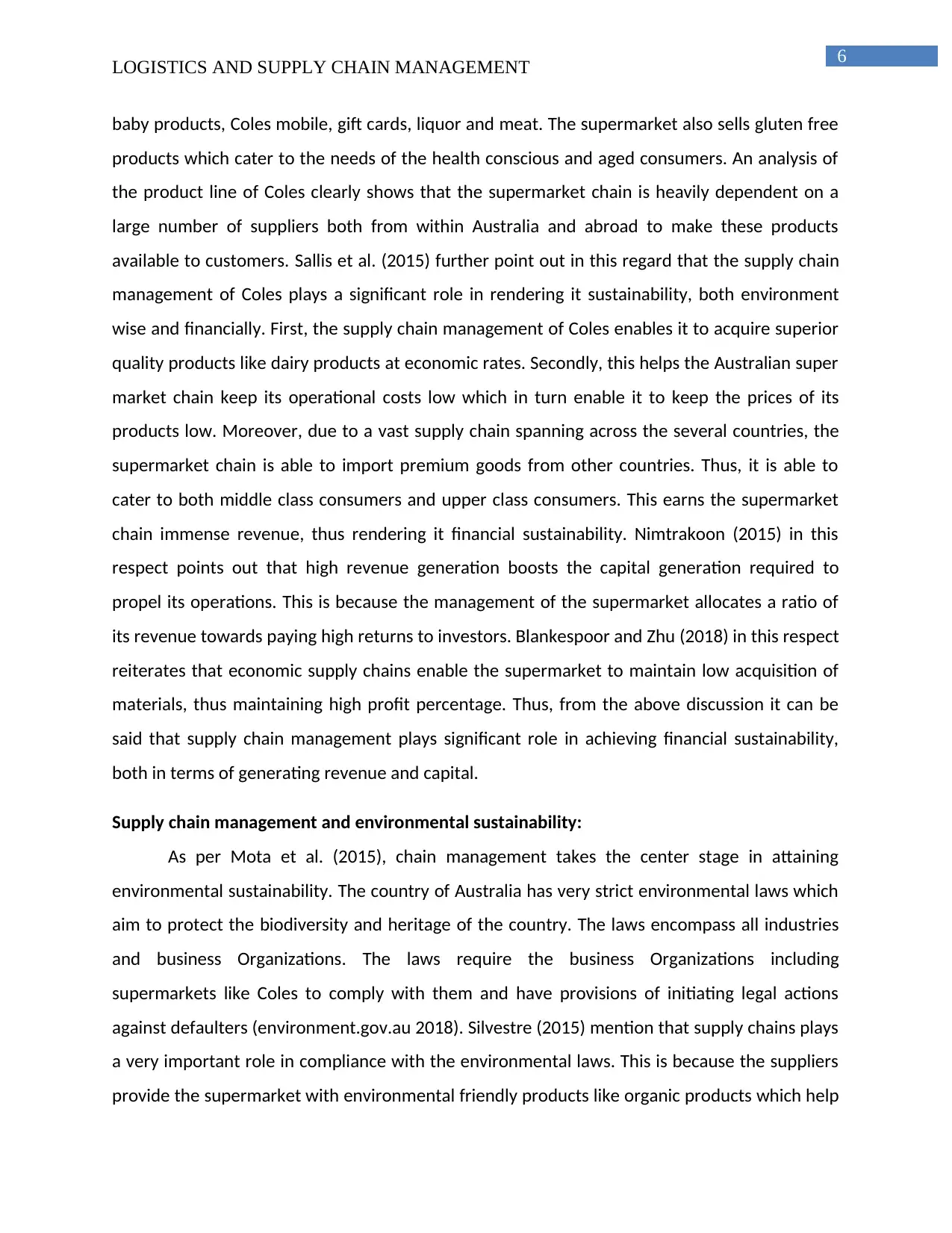
6
LOGISTICS AND SUPPLY CHAIN MANAGEMENT
baby products, Coles mobile, gift cards, liquor and meat. The supermarket also sells gluten free
products which cater to the needs of the health conscious and aged consumers. An analysis of
the product line of Coles clearly shows that the supermarket chain is heavily dependent on a
large number of suppliers both from within Australia and abroad to make these products
available to customers. Sallis et al. (2015) further point out in this regard that the supply chain
management of Coles plays a significant role in rendering it sustainability, both environment
wise and financially. First, the supply chain management of Coles enables it to acquire superior
quality products like dairy products at economic rates. Secondly, this helps the Australian super
market chain keep its operational costs low which in turn enable it to keep the prices of its
products low. Moreover, due to a vast supply chain spanning across the several countries, the
supermarket chain is able to import premium goods from other countries. Thus, it is able to
cater to both middle class consumers and upper class consumers. This earns the supermarket
chain immense revenue, thus rendering it financial sustainability. Nimtrakoon (2015) in this
respect points out that high revenue generation boosts the capital generation required to
propel its operations. This is because the management of the supermarket allocates a ratio of
its revenue towards paying high returns to investors. Blankespoor and Zhu (2018) in this respect
reiterates that economic supply chains enable the supermarket to maintain low acquisition of
materials, thus maintaining high profit percentage. Thus, from the above discussion it can be
said that supply chain management plays significant role in achieving financial sustainability,
both in terms of generating revenue and capital.
Supply chain management and environmental sustainability:
As per Mota et al. (2015), chain management takes the center stage in attaining
environmental sustainability. The country of Australia has very strict environmental laws which
aim to protect the biodiversity and heritage of the country. The laws encompass all industries
and business Organizations. The laws require the business Organizations including
supermarkets like Coles to comply with them and have provisions of initiating legal actions
against defaulters (environment.gov.au 2018). Silvestre (2015) mention that supply chains plays
a very important role in compliance with the environmental laws. This is because the suppliers
provide the supermarket with environmental friendly products like organic products which help
LOGISTICS AND SUPPLY CHAIN MANAGEMENT
baby products, Coles mobile, gift cards, liquor and meat. The supermarket also sells gluten free
products which cater to the needs of the health conscious and aged consumers. An analysis of
the product line of Coles clearly shows that the supermarket chain is heavily dependent on a
large number of suppliers both from within Australia and abroad to make these products
available to customers. Sallis et al. (2015) further point out in this regard that the supply chain
management of Coles plays a significant role in rendering it sustainability, both environment
wise and financially. First, the supply chain management of Coles enables it to acquire superior
quality products like dairy products at economic rates. Secondly, this helps the Australian super
market chain keep its operational costs low which in turn enable it to keep the prices of its
products low. Moreover, due to a vast supply chain spanning across the several countries, the
supermarket chain is able to import premium goods from other countries. Thus, it is able to
cater to both middle class consumers and upper class consumers. This earns the supermarket
chain immense revenue, thus rendering it financial sustainability. Nimtrakoon (2015) in this
respect points out that high revenue generation boosts the capital generation required to
propel its operations. This is because the management of the supermarket allocates a ratio of
its revenue towards paying high returns to investors. Blankespoor and Zhu (2018) in this respect
reiterates that economic supply chains enable the supermarket to maintain low acquisition of
materials, thus maintaining high profit percentage. Thus, from the above discussion it can be
said that supply chain management plays significant role in achieving financial sustainability,
both in terms of generating revenue and capital.
Supply chain management and environmental sustainability:
As per Mota et al. (2015), chain management takes the center stage in attaining
environmental sustainability. The country of Australia has very strict environmental laws which
aim to protect the biodiversity and heritage of the country. The laws encompass all industries
and business Organizations. The laws require the business Organizations including
supermarkets like Coles to comply with them and have provisions of initiating legal actions
against defaulters (environment.gov.au 2018). Silvestre (2015) mention that supply chains plays
a very important role in compliance with the environmental laws. This is because the suppliers
provide the supermarket with environmental friendly products like organic products which help
⊘ This is a preview!⊘
Do you want full access?
Subscribe today to unlock all pages.

Trusted by 1+ million students worldwide
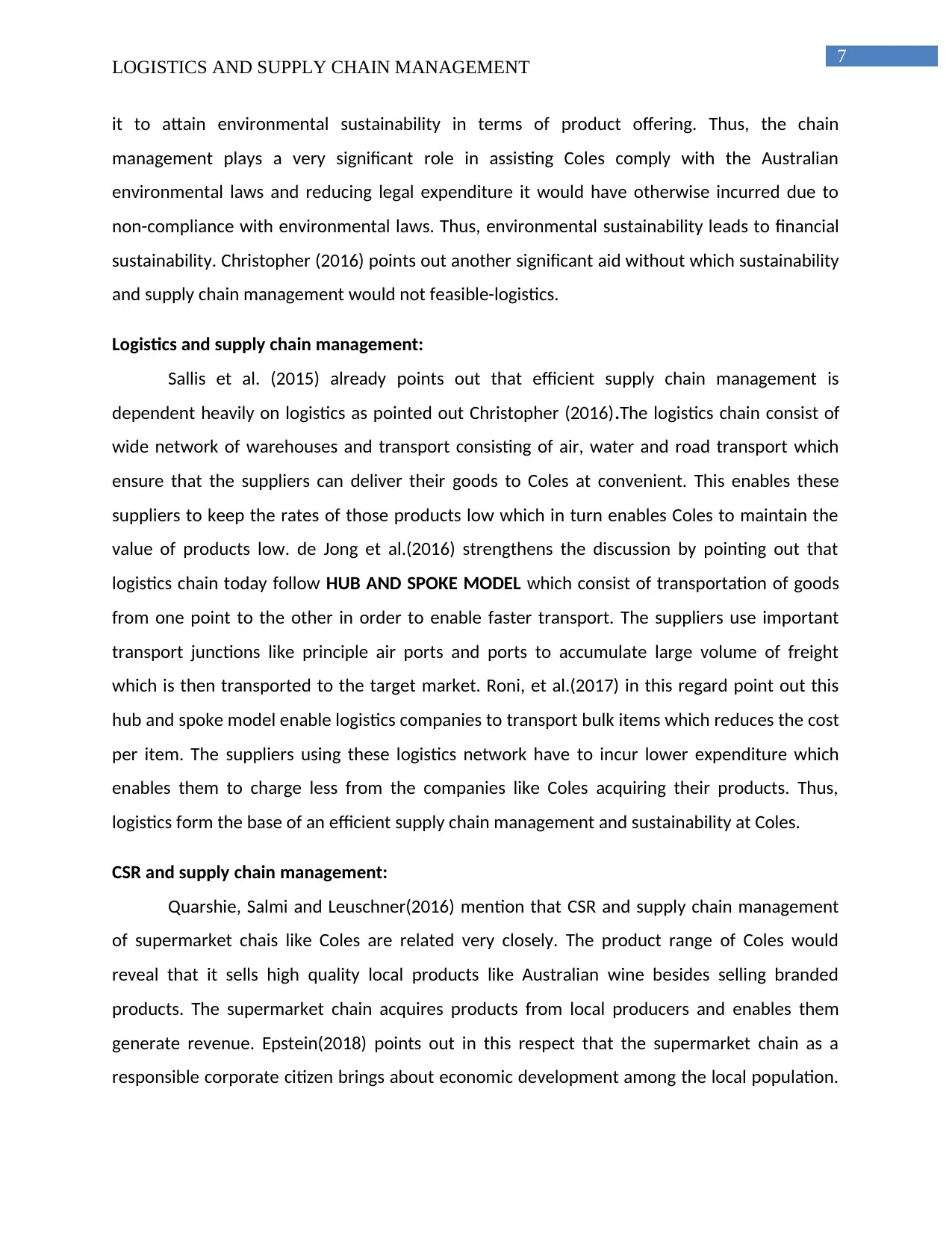
7
LOGISTICS AND SUPPLY CHAIN MANAGEMENT
it to attain environmental sustainability in terms of product offering. Thus, the chain
management plays a very significant role in assisting Coles comply with the Australian
environmental laws and reducing legal expenditure it would have otherwise incurred due to
non-compliance with environmental laws. Thus, environmental sustainability leads to financial
sustainability. Christopher (2016) points out another significant aid without which sustainability
and supply chain management would not feasible-logistics.
Logistics and supply chain management:
Sallis et al. (2015) already points out that efficient supply chain management is
dependent heavily on logistics as pointed out Christopher (2016).The logistics chain consist of
wide network of warehouses and transport consisting of air, water and road transport which
ensure that the suppliers can deliver their goods to Coles at convenient. This enables these
suppliers to keep the rates of those products low which in turn enables Coles to maintain the
value of products low. de Jong et al.(2016) strengthens the discussion by pointing out that
logistics chain today follow HUB AND SPOKE MODEL which consist of transportation of goods
from one point to the other in order to enable faster transport. The suppliers use important
transport junctions like principle air ports and ports to accumulate large volume of freight
which is then transported to the target market. Roni, et al.(2017) in this regard point out this
hub and spoke model enable logistics companies to transport bulk items which reduces the cost
per item. The suppliers using these logistics network have to incur lower expenditure which
enables them to charge less from the companies like Coles acquiring their products. Thus,
logistics form the base of an efficient supply chain management and sustainability at Coles.
CSR and supply chain management:
Quarshie, Salmi and Leuschner(2016) mention that CSR and supply chain management
of supermarket chais like Coles are related very closely. The product range of Coles would
reveal that it sells high quality local products like Australian wine besides selling branded
products. The supermarket chain acquires products from local producers and enables them
generate revenue. Epstein(2018) points out in this respect that the supermarket chain as a
responsible corporate citizen brings about economic development among the local population.
LOGISTICS AND SUPPLY CHAIN MANAGEMENT
it to attain environmental sustainability in terms of product offering. Thus, the chain
management plays a very significant role in assisting Coles comply with the Australian
environmental laws and reducing legal expenditure it would have otherwise incurred due to
non-compliance with environmental laws. Thus, environmental sustainability leads to financial
sustainability. Christopher (2016) points out another significant aid without which sustainability
and supply chain management would not feasible-logistics.
Logistics and supply chain management:
Sallis et al. (2015) already points out that efficient supply chain management is
dependent heavily on logistics as pointed out Christopher (2016).The logistics chain consist of
wide network of warehouses and transport consisting of air, water and road transport which
ensure that the suppliers can deliver their goods to Coles at convenient. This enables these
suppliers to keep the rates of those products low which in turn enables Coles to maintain the
value of products low. de Jong et al.(2016) strengthens the discussion by pointing out that
logistics chain today follow HUB AND SPOKE MODEL which consist of transportation of goods
from one point to the other in order to enable faster transport. The suppliers use important
transport junctions like principle air ports and ports to accumulate large volume of freight
which is then transported to the target market. Roni, et al.(2017) in this regard point out this
hub and spoke model enable logistics companies to transport bulk items which reduces the cost
per item. The suppliers using these logistics network have to incur lower expenditure which
enables them to charge less from the companies like Coles acquiring their products. Thus,
logistics form the base of an efficient supply chain management and sustainability at Coles.
CSR and supply chain management:
Quarshie, Salmi and Leuschner(2016) mention that CSR and supply chain management
of supermarket chais like Coles are related very closely. The product range of Coles would
reveal that it sells high quality local products like Australian wine besides selling branded
products. The supermarket chain acquires products from local producers and enables them
generate revenue. Epstein(2018) points out in this respect that the supermarket chain as a
responsible corporate citizen brings about economic development among the local population.
Paraphrase This Document
Need a fresh take? Get an instant paraphrase of this document with our AI Paraphraser
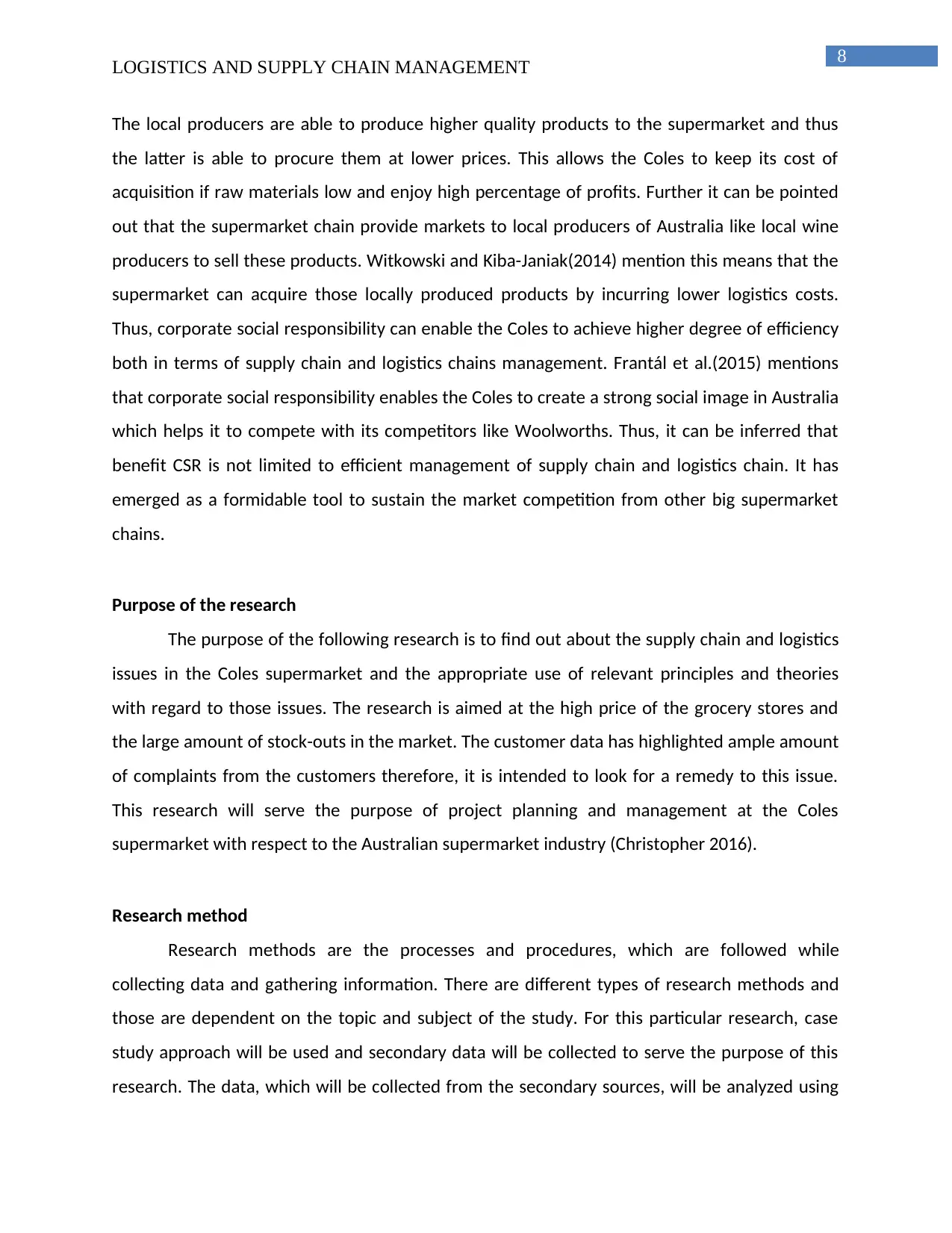
8
LOGISTICS AND SUPPLY CHAIN MANAGEMENT
The local producers are able to produce higher quality products to the supermarket and thus
the latter is able to procure them at lower prices. This allows the Coles to keep its cost of
acquisition if raw materials low and enjoy high percentage of profits. Further it can be pointed
out that the supermarket chain provide markets to local producers of Australia like local wine
producers to sell these products. Witkowski and Kiba-Janiak(2014) mention this means that the
supermarket can acquire those locally produced products by incurring lower logistics costs.
Thus, corporate social responsibility can enable the Coles to achieve higher degree of efficiency
both in terms of supply chain and logistics chains management. Frantál et al.(2015) mentions
that corporate social responsibility enables the Coles to create a strong social image in Australia
which helps it to compete with its competitors like Woolworths. Thus, it can be inferred that
benefit CSR is not limited to efficient management of supply chain and logistics chain. It has
emerged as a formidable tool to sustain the market competition from other big supermarket
chains.
Purpose of the research
The purpose of the following research is to find out about the supply chain and logistics
issues in the Coles supermarket and the appropriate use of relevant principles and theories
with regard to those issues. The research is aimed at the high price of the grocery stores and
the large amount of stock-outs in the market. The customer data has highlighted ample amount
of complaints from the customers therefore, it is intended to look for a remedy to this issue.
This research will serve the purpose of project planning and management at the Coles
supermarket with respect to the Australian supermarket industry (Christopher 2016).
Research method
Research methods are the processes and procedures, which are followed while
collecting data and gathering information. There are different types of research methods and
those are dependent on the topic and subject of the study. For this particular research, case
study approach will be used and secondary data will be collected to serve the purpose of this
research. The data, which will be collected from the secondary sources, will be analyzed using
LOGISTICS AND SUPPLY CHAIN MANAGEMENT
The local producers are able to produce higher quality products to the supermarket and thus
the latter is able to procure them at lower prices. This allows the Coles to keep its cost of
acquisition if raw materials low and enjoy high percentage of profits. Further it can be pointed
out that the supermarket chain provide markets to local producers of Australia like local wine
producers to sell these products. Witkowski and Kiba-Janiak(2014) mention this means that the
supermarket can acquire those locally produced products by incurring lower logistics costs.
Thus, corporate social responsibility can enable the Coles to achieve higher degree of efficiency
both in terms of supply chain and logistics chains management. Frantál et al.(2015) mentions
that corporate social responsibility enables the Coles to create a strong social image in Australia
which helps it to compete with its competitors like Woolworths. Thus, it can be inferred that
benefit CSR is not limited to efficient management of supply chain and logistics chain. It has
emerged as a formidable tool to sustain the market competition from other big supermarket
chains.
Purpose of the research
The purpose of the following research is to find out about the supply chain and logistics
issues in the Coles supermarket and the appropriate use of relevant principles and theories
with regard to those issues. The research is aimed at the high price of the grocery stores and
the large amount of stock-outs in the market. The customer data has highlighted ample amount
of complaints from the customers therefore, it is intended to look for a remedy to this issue.
This research will serve the purpose of project planning and management at the Coles
supermarket with respect to the Australian supermarket industry (Christopher 2016).
Research method
Research methods are the processes and procedures, which are followed while
collecting data and gathering information. There are different types of research methods and
those are dependent on the topic and subject of the study. For this particular research, case
study approach will be used and secondary data will be collected to serve the purpose of this
research. The data, which will be collected from the secondary sources, will be analyzed using
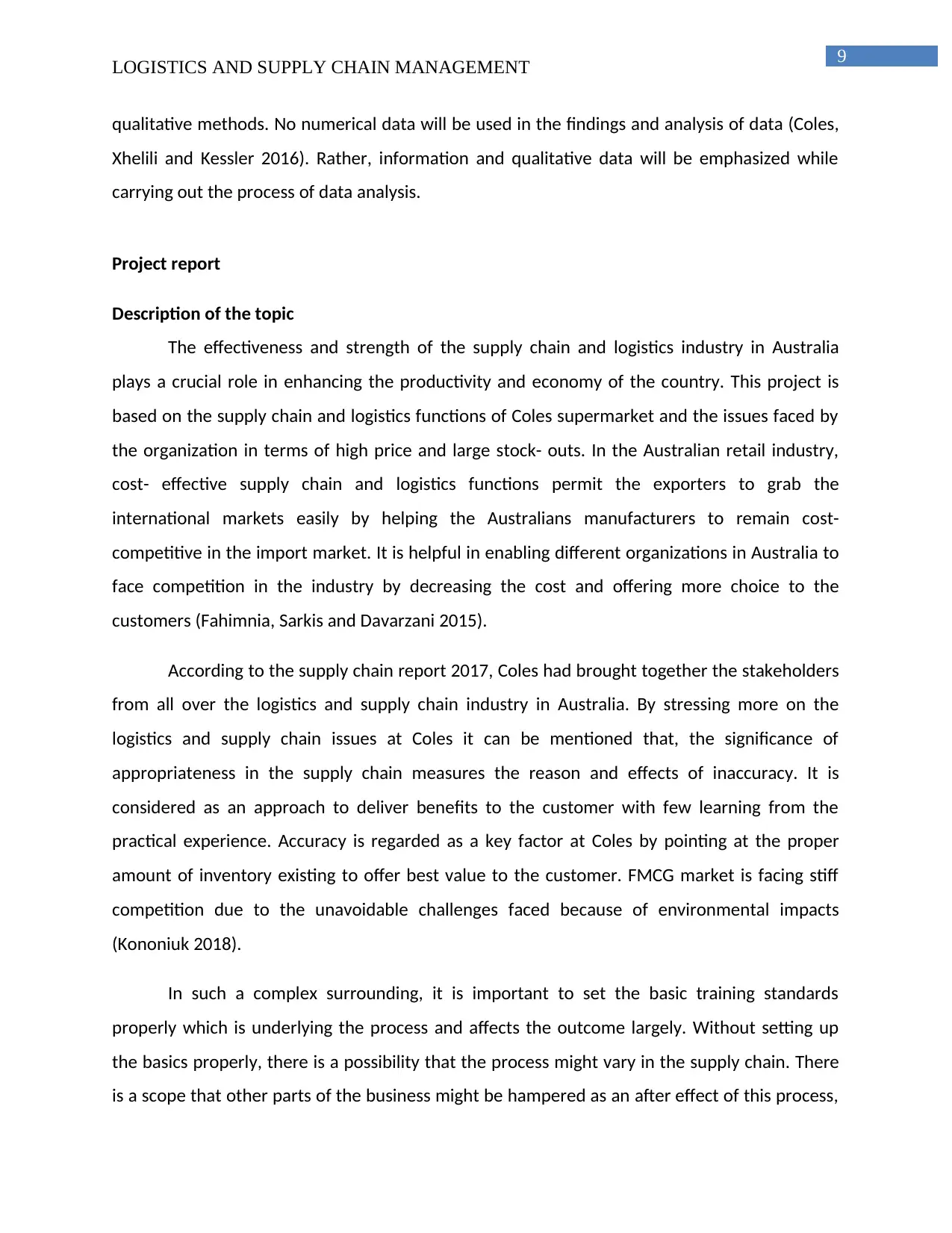
9
LOGISTICS AND SUPPLY CHAIN MANAGEMENT
qualitative methods. No numerical data will be used in the findings and analysis of data (Coles,
Xhelili and Kessler 2016). Rather, information and qualitative data will be emphasized while
carrying out the process of data analysis.
Project report
Description of the topic
The effectiveness and strength of the supply chain and logistics industry in Australia
plays a crucial role in enhancing the productivity and economy of the country. This project is
based on the supply chain and logistics functions of Coles supermarket and the issues faced by
the organization in terms of high price and large stock- outs. In the Australian retail industry,
cost- effective supply chain and logistics functions permit the exporters to grab the
international markets easily by helping the Australians manufacturers to remain cost-
competitive in the import market. It is helpful in enabling different organizations in Australia to
face competition in the industry by decreasing the cost and offering more choice to the
customers (Fahimnia, Sarkis and Davarzani 2015).
According to the supply chain report 2017, Coles had brought together the stakeholders
from all over the logistics and supply chain industry in Australia. By stressing more on the
logistics and supply chain issues at Coles it can be mentioned that, the significance of
appropriateness in the supply chain measures the reason and effects of inaccuracy. It is
considered as an approach to deliver benefits to the customer with few learning from the
practical experience. Accuracy is regarded as a key factor at Coles by pointing at the proper
amount of inventory existing to offer best value to the customer. FMCG market is facing stiff
competition due to the unavoidable challenges faced because of environmental impacts
(Kononiuk 2018).
In such a complex surrounding, it is important to set the basic training standards
properly which is underlying the process and affects the outcome largely. Without setting up
the basics properly, there is a possibility that the process might vary in the supply chain. There
is a scope that other parts of the business might be hampered as an after effect of this process,
LOGISTICS AND SUPPLY CHAIN MANAGEMENT
qualitative methods. No numerical data will be used in the findings and analysis of data (Coles,
Xhelili and Kessler 2016). Rather, information and qualitative data will be emphasized while
carrying out the process of data analysis.
Project report
Description of the topic
The effectiveness and strength of the supply chain and logistics industry in Australia
plays a crucial role in enhancing the productivity and economy of the country. This project is
based on the supply chain and logistics functions of Coles supermarket and the issues faced by
the organization in terms of high price and large stock- outs. In the Australian retail industry,
cost- effective supply chain and logistics functions permit the exporters to grab the
international markets easily by helping the Australians manufacturers to remain cost-
competitive in the import market. It is helpful in enabling different organizations in Australia to
face competition in the industry by decreasing the cost and offering more choice to the
customers (Fahimnia, Sarkis and Davarzani 2015).
According to the supply chain report 2017, Coles had brought together the stakeholders
from all over the logistics and supply chain industry in Australia. By stressing more on the
logistics and supply chain issues at Coles it can be mentioned that, the significance of
appropriateness in the supply chain measures the reason and effects of inaccuracy. It is
considered as an approach to deliver benefits to the customer with few learning from the
practical experience. Accuracy is regarded as a key factor at Coles by pointing at the proper
amount of inventory existing to offer best value to the customer. FMCG market is facing stiff
competition due to the unavoidable challenges faced because of environmental impacts
(Kononiuk 2018).
In such a complex surrounding, it is important to set the basic training standards
properly which is underlying the process and affects the outcome largely. Without setting up
the basics properly, there is a possibility that the process might vary in the supply chain. There
is a scope that other parts of the business might be hampered as an after effect of this process,
⊘ This is a preview!⊘
Do you want full access?
Subscribe today to unlock all pages.

Trusted by 1+ million students worldwide
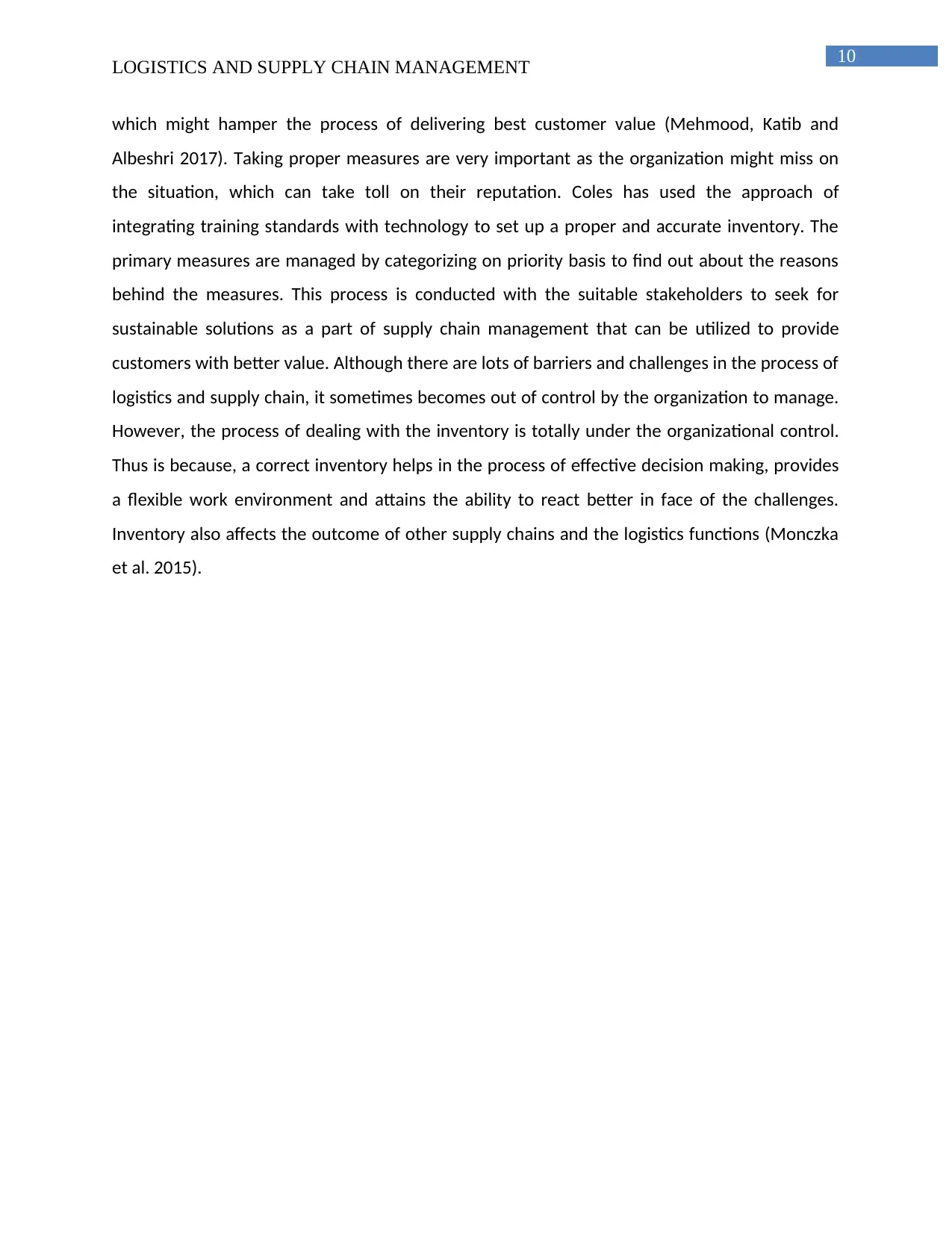
10
LOGISTICS AND SUPPLY CHAIN MANAGEMENT
which might hamper the process of delivering best customer value (Mehmood, Katib and
Albeshri 2017). Taking proper measures are very important as the organization might miss on
the situation, which can take toll on their reputation. Coles has used the approach of
integrating training standards with technology to set up a proper and accurate inventory. The
primary measures are managed by categorizing on priority basis to find out about the reasons
behind the measures. This process is conducted with the suitable stakeholders to seek for
sustainable solutions as a part of supply chain management that can be utilized to provide
customers with better value. Although there are lots of barriers and challenges in the process of
logistics and supply chain, it sometimes becomes out of control by the organization to manage.
However, the process of dealing with the inventory is totally under the organizational control.
Thus is because, a correct inventory helps in the process of effective decision making, provides
a flexible work environment and attains the ability to react better in face of the challenges.
Inventory also affects the outcome of other supply chains and the logistics functions (Monczka
et al. 2015).
LOGISTICS AND SUPPLY CHAIN MANAGEMENT
which might hamper the process of delivering best customer value (Mehmood, Katib and
Albeshri 2017). Taking proper measures are very important as the organization might miss on
the situation, which can take toll on their reputation. Coles has used the approach of
integrating training standards with technology to set up a proper and accurate inventory. The
primary measures are managed by categorizing on priority basis to find out about the reasons
behind the measures. This process is conducted with the suitable stakeholders to seek for
sustainable solutions as a part of supply chain management that can be utilized to provide
customers with better value. Although there are lots of barriers and challenges in the process of
logistics and supply chain, it sometimes becomes out of control by the organization to manage.
However, the process of dealing with the inventory is totally under the organizational control.
Thus is because, a correct inventory helps in the process of effective decision making, provides
a flexible work environment and attains the ability to react better in face of the challenges.
Inventory also affects the outcome of other supply chains and the logistics functions (Monczka
et al. 2015).
Paraphrase This Document
Need a fresh take? Get an instant paraphrase of this document with our AI Paraphraser
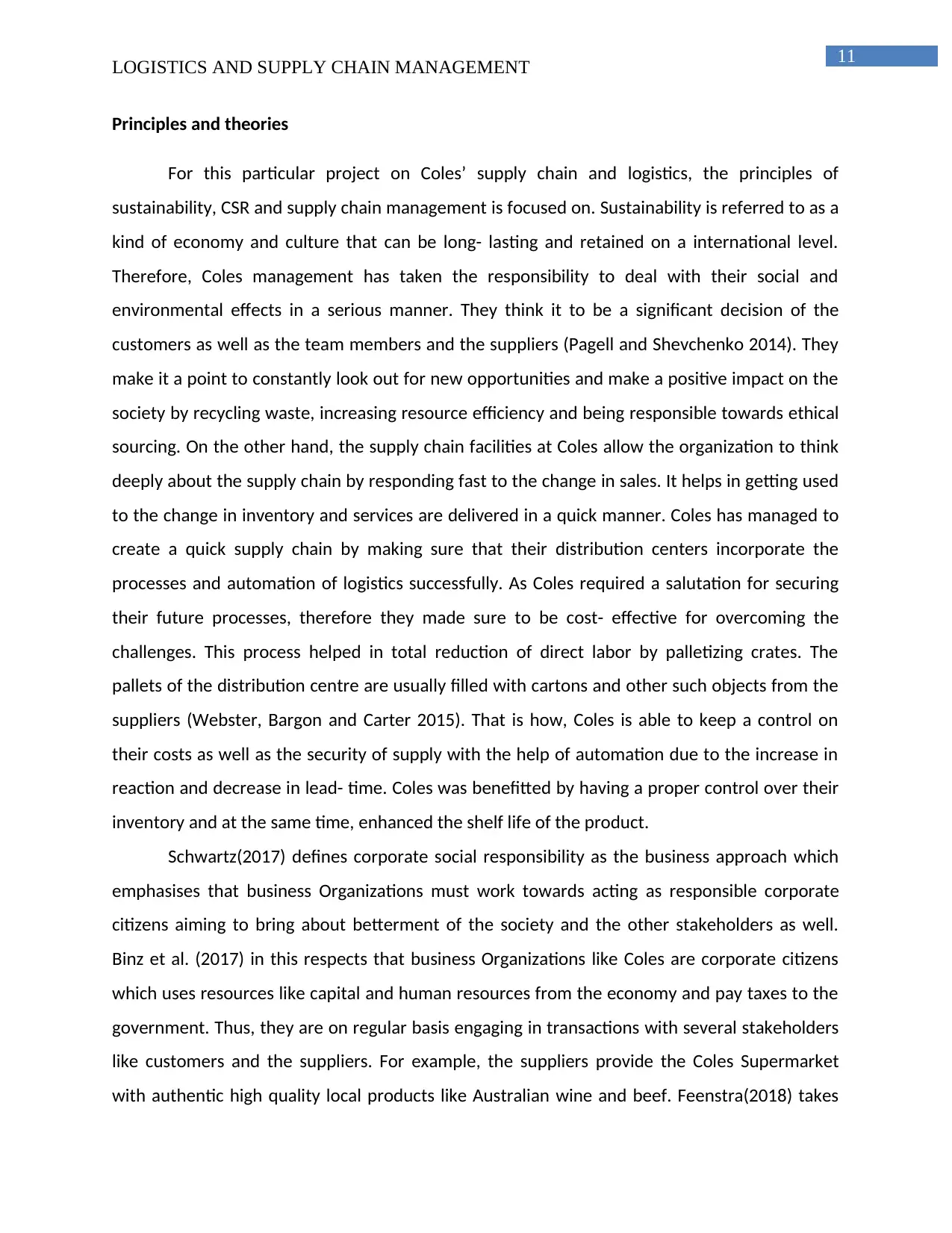
11
LOGISTICS AND SUPPLY CHAIN MANAGEMENT
Principles and theories
For this particular project on Coles’ supply chain and logistics, the principles of
sustainability, CSR and supply chain management is focused on. Sustainability is referred to as a
kind of economy and culture that can be long- lasting and retained on a international level.
Therefore, Coles management has taken the responsibility to deal with their social and
environmental effects in a serious manner. They think it to be a significant decision of the
customers as well as the team members and the suppliers (Pagell and Shevchenko 2014). They
make it a point to constantly look out for new opportunities and make a positive impact on the
society by recycling waste, increasing resource efficiency and being responsible towards ethical
sourcing. On the other hand, the supply chain facilities at Coles allow the organization to think
deeply about the supply chain by responding fast to the change in sales. It helps in getting used
to the change in inventory and services are delivered in a quick manner. Coles has managed to
create a quick supply chain by making sure that their distribution centers incorporate the
processes and automation of logistics successfully. As Coles required a salutation for securing
their future processes, therefore they made sure to be cost- effective for overcoming the
challenges. This process helped in total reduction of direct labor by palletizing crates. The
pallets of the distribution centre are usually filled with cartons and other such objects from the
suppliers (Webster, Bargon and Carter 2015). That is how, Coles is able to keep a control on
their costs as well as the security of supply with the help of automation due to the increase in
reaction and decrease in lead- time. Coles was benefitted by having a proper control over their
inventory and at the same time, enhanced the shelf life of the product.
Schwartz(2017) defines corporate social responsibility as the business approach which
emphasises that business Organizations must work towards acting as responsible corporate
citizens aiming to bring about betterment of the society and the other stakeholders as well.
Binz et al. (2017) in this respects that business Organizations like Coles are corporate citizens
which uses resources like capital and human resources from the economy and pay taxes to the
government. Thus, they are on regular basis engaging in transactions with several stakeholders
like customers and the suppliers. For example, the suppliers provide the Coles Supermarket
with authentic high quality local products like Australian wine and beef. Feenstra(2018) takes
LOGISTICS AND SUPPLY CHAIN MANAGEMENT
Principles and theories
For this particular project on Coles’ supply chain and logistics, the principles of
sustainability, CSR and supply chain management is focused on. Sustainability is referred to as a
kind of economy and culture that can be long- lasting and retained on a international level.
Therefore, Coles management has taken the responsibility to deal with their social and
environmental effects in a serious manner. They think it to be a significant decision of the
customers as well as the team members and the suppliers (Pagell and Shevchenko 2014). They
make it a point to constantly look out for new opportunities and make a positive impact on the
society by recycling waste, increasing resource efficiency and being responsible towards ethical
sourcing. On the other hand, the supply chain facilities at Coles allow the organization to think
deeply about the supply chain by responding fast to the change in sales. It helps in getting used
to the change in inventory and services are delivered in a quick manner. Coles has managed to
create a quick supply chain by making sure that their distribution centers incorporate the
processes and automation of logistics successfully. As Coles required a salutation for securing
their future processes, therefore they made sure to be cost- effective for overcoming the
challenges. This process helped in total reduction of direct labor by palletizing crates. The
pallets of the distribution centre are usually filled with cartons and other such objects from the
suppliers (Webster, Bargon and Carter 2015). That is how, Coles is able to keep a control on
their costs as well as the security of supply with the help of automation due to the increase in
reaction and decrease in lead- time. Coles was benefitted by having a proper control over their
inventory and at the same time, enhanced the shelf life of the product.
Schwartz(2017) defines corporate social responsibility as the business approach which
emphasises that business Organizations must work towards acting as responsible corporate
citizens aiming to bring about betterment of the society and the other stakeholders as well.
Binz et al. (2017) in this respects that business Organizations like Coles are corporate citizens
which uses resources like capital and human resources from the economy and pay taxes to the
government. Thus, they are on regular basis engaging in transactions with several stakeholders
like customers and the suppliers. For example, the suppliers provide the Coles Supermarket
with authentic high quality local products like Australian wine and beef. Feenstra(2018) takes
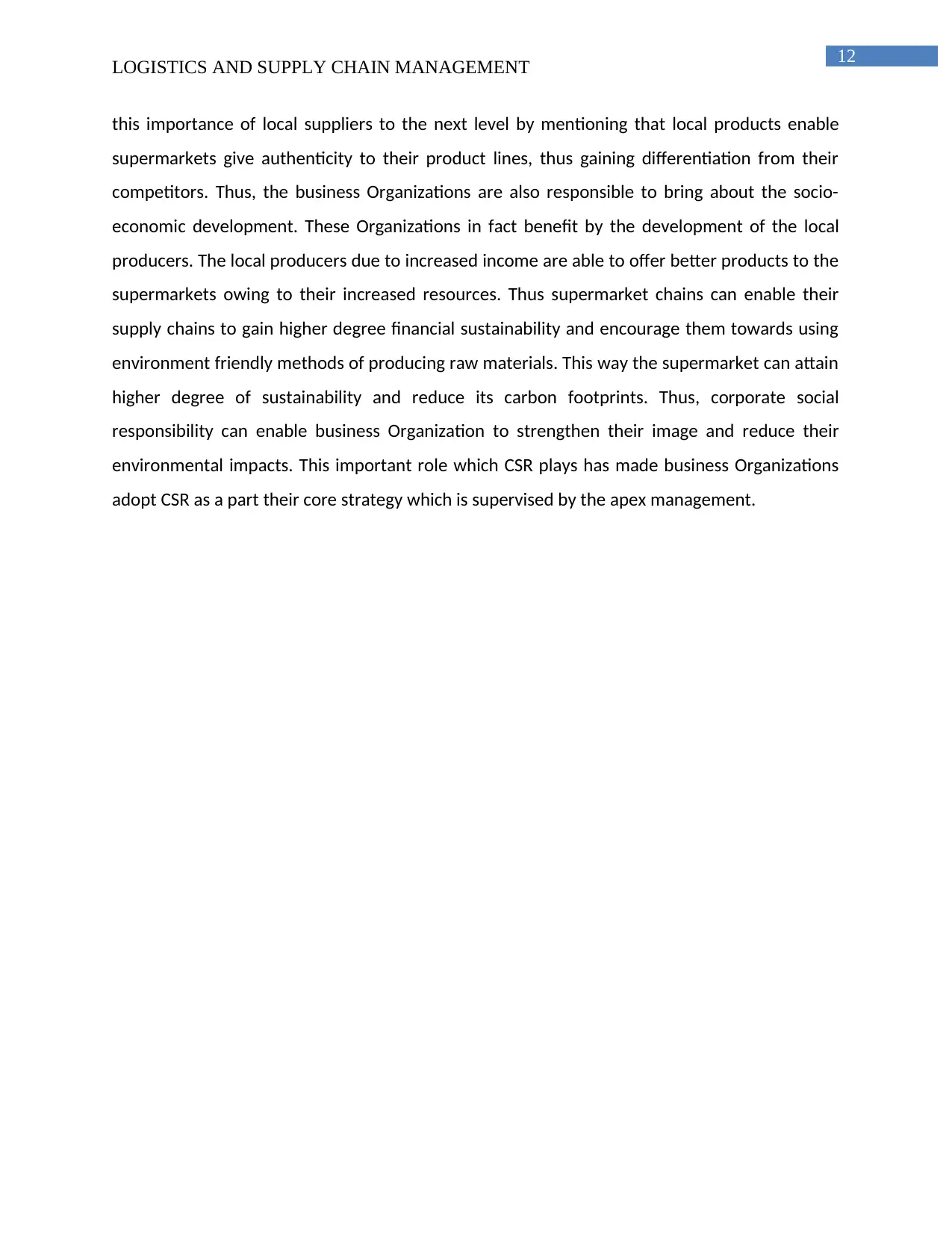
12
LOGISTICS AND SUPPLY CHAIN MANAGEMENT
this importance of local suppliers to the next level by mentioning that local products enable
supermarkets give authenticity to their product lines, thus gaining differentiation from their
competitors. Thus, the business Organizations are also responsible to bring about the socio-
economic development. These Organizations in fact benefit by the development of the local
producers. The local producers due to increased income are able to offer better products to the
supermarkets owing to their increased resources. Thus supermarket chains can enable their
supply chains to gain higher degree financial sustainability and encourage them towards using
environment friendly methods of producing raw materials. This way the supermarket can attain
higher degree of sustainability and reduce its carbon footprints. Thus, corporate social
responsibility can enable business Organization to strengthen their image and reduce their
environmental impacts. This important role which CSR plays has made business Organizations
adopt CSR as a part their core strategy which is supervised by the apex management.
LOGISTICS AND SUPPLY CHAIN MANAGEMENT
this importance of local suppliers to the next level by mentioning that local products enable
supermarkets give authenticity to their product lines, thus gaining differentiation from their
competitors. Thus, the business Organizations are also responsible to bring about the socio-
economic development. These Organizations in fact benefit by the development of the local
producers. The local producers due to increased income are able to offer better products to the
supermarkets owing to their increased resources. Thus supermarket chains can enable their
supply chains to gain higher degree financial sustainability and encourage them towards using
environment friendly methods of producing raw materials. This way the supermarket can attain
higher degree of sustainability and reduce its carbon footprints. Thus, corporate social
responsibility can enable business Organization to strengthen their image and reduce their
environmental impacts. This important role which CSR plays has made business Organizations
adopt CSR as a part their core strategy which is supervised by the apex management.
⊘ This is a preview!⊘
Do you want full access?
Subscribe today to unlock all pages.

Trusted by 1+ million students worldwide
1 out of 25
Related Documents
Your All-in-One AI-Powered Toolkit for Academic Success.
+13062052269
info@desklib.com
Available 24*7 on WhatsApp / Email
![[object Object]](/_next/static/media/star-bottom.7253800d.svg)
Unlock your academic potential
Copyright © 2020–2025 A2Z Services. All Rights Reserved. Developed and managed by ZUCOL.





